Request an online demo
Get a personalized online demo of Kount's trust and safety technology at a time and date of your choosing.
13 Tips to Improve Your Return Policy & Prevent Chargebacks (with Examples!)
If you want to effectively prevent chargebacks, you’ll need to be a little creative. There are dozens of things you can do to reduce risk exposure. The trick is finding the strategies that are most effective for your business.
However, there is one thing that nearly all businesses find helpful in their fight to prevent chargebacks, and that is updating their return policy.
How Do Policies Impact Chargebacks?
The card networks (Mastercard, Visa, etc.) have very detailed regulations for payment disputes. One requirement is that cardholders should try to resolve their issues with merchants directly before initiating chargebacks.
That means an easy-to-understand, user-friendly return policy is vitally important.
If cardholders can’t find your policy or your expectations are unrealistic, they’ll bypass you entirely and go straight to the bank.
Studies have found 8 out of 11 banks allow cardholders to dispute transactions with a touch of a button from their website. That’s pretty convenient!
If you want to prevent chargebacks, you need to make it easy for customers to get their money back. If you can’t, the bank will.
How to Use Your Return Policy to Prevent Chargebacks
These 13 policy updates can help reduce the risk of chargebacks:
- Write an easy-to-understand return policy.
- Consider a longer timeline.
- Consider offering free return shipping.
- Adhere to state laws and card network regulations.
- Be polite.
- Clearly state your expectations.
- Clearly state what you will offer.
- Include FAQs.
- Share customer testimonials.
- Honor old versions of your policy.
- Monitor your outcomes.
- Make it easy to find your policy.
- Educate your staff.
1. Write an easy-to-understand return policy.
If you read nothing else in this article, read this! Your policy needs to be clear and easy-to-understand.
If customers can’t figure out how to resolve issues with you directly, the only option they have is to go to the bank for a chargeback.
- Write the way you would speak if the customer was standing in front of you.
- Write short sentences and short paragraphs.
- Use simple, direct, common words—no confusing jargon.
- Write for an international audience that might not speak your native language fluently.
- Have an objective outsider read your copy and give you feedback.
Take a look at Kohl’s return policy for online orders. The page has a concise explanation with links to more information if the visitor wants to dive deeper.
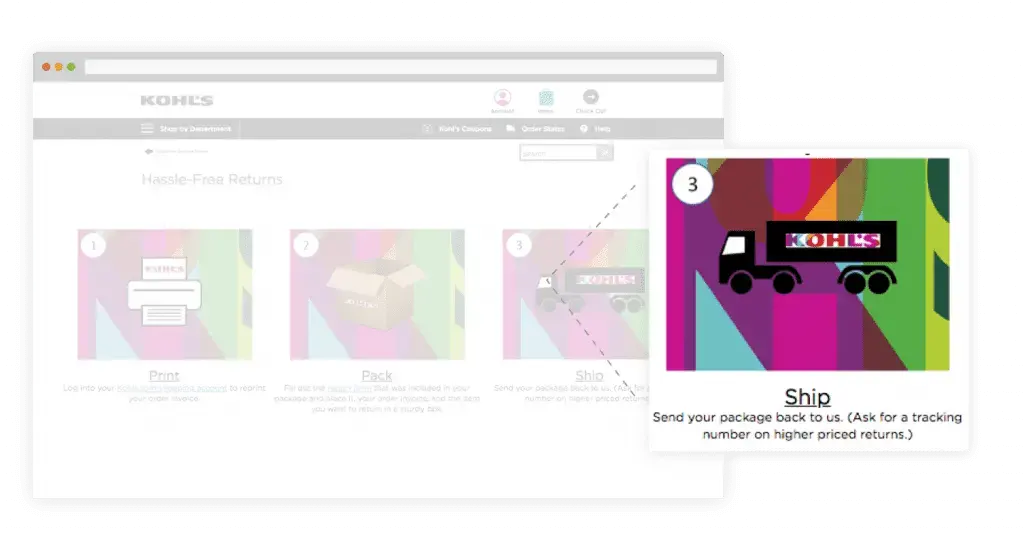
2. Consider a longer timeline.
Most chargebacks have a 120-day time limit — meaning customers can wait nearly four months to dispute their purchases.
Card networks likely selected this timeline because they felt it could potentially take customers that long to discover issues related to their purchases. Is it realistic to expect customers to make returns within a week? Or even 30 days?
If customers feel entitled to their money back and your return time limit has expired, a chargeback will be pretty appealing.
You should consider extending your return time limit so it is at least as long as the chargeback time limit.
For example, L.L. Bean allows returns for up to one year after the purchase, and there are no time limits for issues related to quality or craftsmanship.
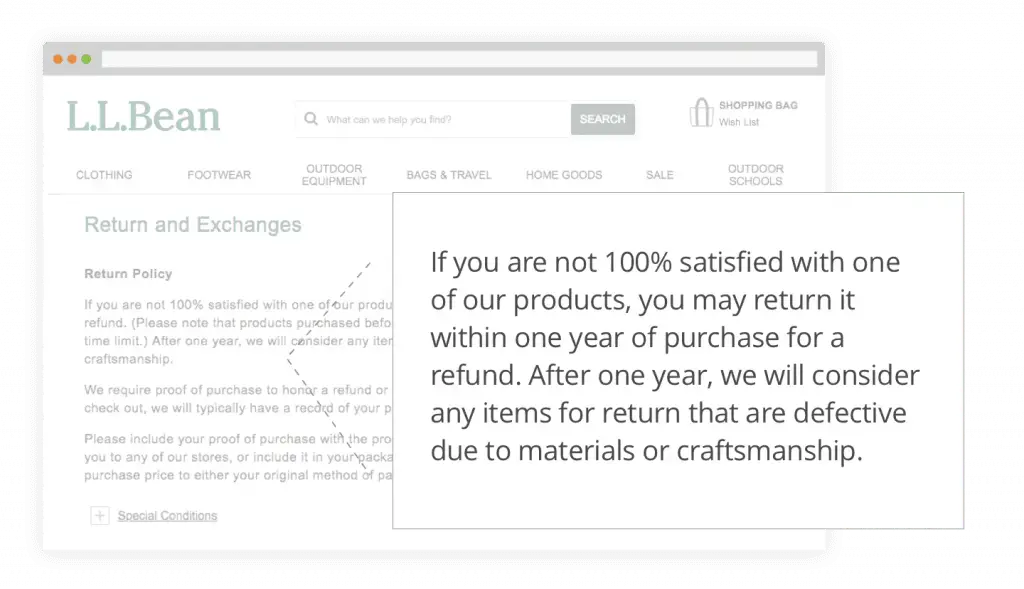
3. Consider offering free return shipping.
Of all the tips we offer here, this is probably the one you’ll have the strongest objection to. After all, returns are expensive enough as it is. Why are we suggesting you cut your profits even more?
Because chargebacks are worse — for three reasons:
|
More than 80% of customers have said they expect return shipping to be free. If you make the shopper pay for shipping but there are no costs associated with a chargeback and the customer gets to keep the merchandise, chargebacks look like a pretty sweet deal.
Zappos boasts that, “customers enjoy free shipping, free returns, and 24/7 customer service!”
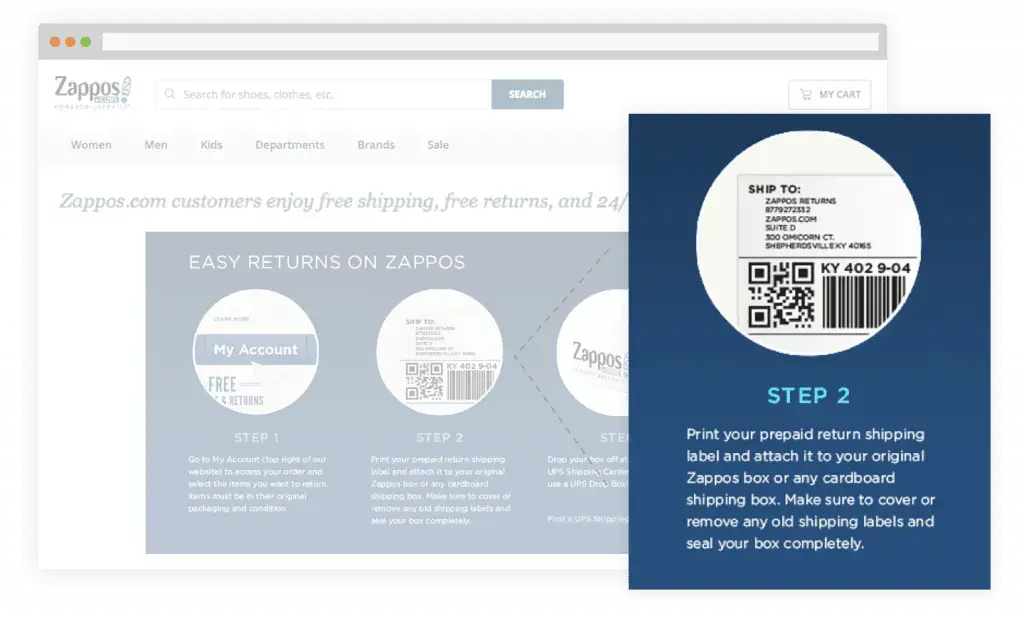
4. Adhere to state laws and card network regulations.
Your return policy must comply with both state laws and card network regulations. Rules typically apply to minimum time limits and how your policy is shared with customers.
Here are some examples:
Image  | If the merchant does not post a return policy, the law requires the business to accept returns within 30 days of purchase |
Image  | Clearly disclose your return/cancelation policy near the customer signature line on transaction receipts. |
5. Be polite.
If customers are being courteous enough to consider a refund instead of a friendly fraud chargeback, it would be best to likewise be courteous!
Put a positive spin on your words instead of negative. Make it seem like the customer is doing you a favor instead of the other way around. Avoid phrases like these:
|
Check out how Pipsticks phrases their policy:
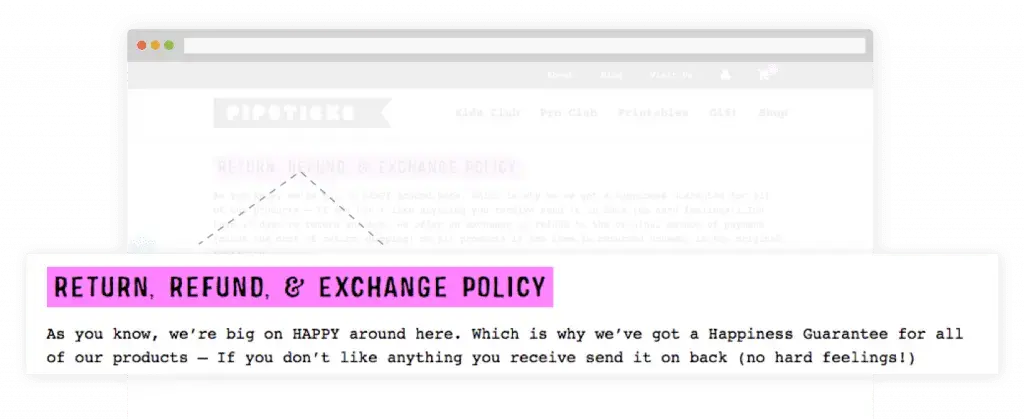
6. Clearly state your expectations.
Explain what cardholders should do if they want a refund.
- Do customers need to put their request in writing? Or will a phone call suffice?
- Are policies the same for all merchandise or are there exceptions? Is merchandise handled the same as digital goods or services?
- Can the customer return merchandise if it was damaged during shipping?
- Can the customer make an exchange instead of a refund?
- How do you want returned merchandise to be packaged? Will you provide a shipping label? Who pays for return shipping?
- What is the time limit?
Remember, to prevent chargebacks, you’ll want your policy to be as simple and user-friendly as possible.
7. Clearly state what you will offer.
Explain how you will respond if a refund request is made.
- Will you credit the customer’s credit card or provide store credit?
- What happens if the purchase was made with a gift card?
- How long will it take for the credit to be applied to the cardholder’s account?
The more accommodating you are, the lower the risk of chargebacks.
After laying out the customer’s responsibilities, LensCrafters explains how the company will respond.
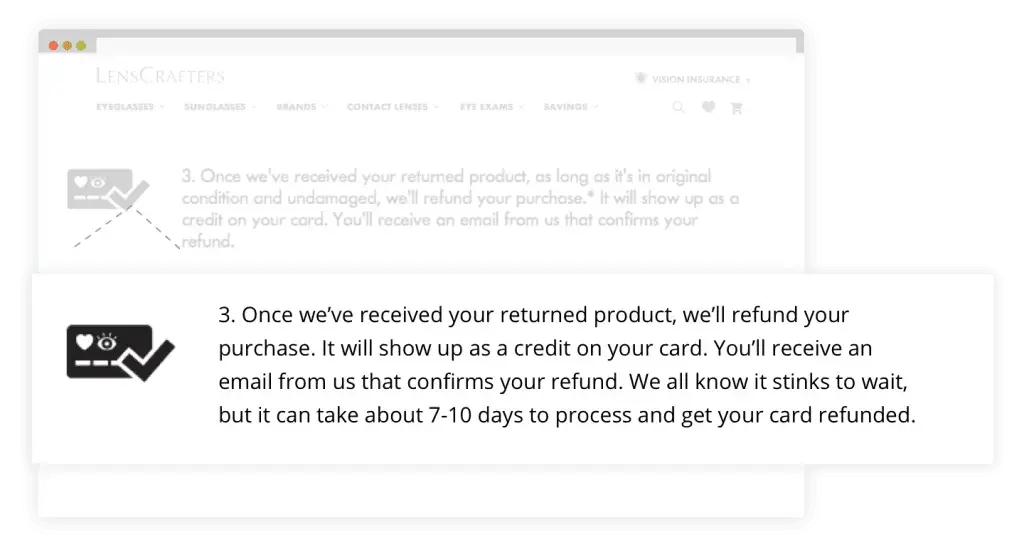
8. Include FAQs.
Even if you take the time to write an easy-to-understand policy that addresses all the essentials, customers will still probably have questions. Other times, visitors won’t want to read your entire policy. They’ll just want to get the most relevant information at a glance.
Listing the questions most commonly asked during the return policy can help improve the user experience and prevent chargebacks.
Frank and Oak cross-references their FAQs by numerous different topics, making it easy to find the most applicable information.
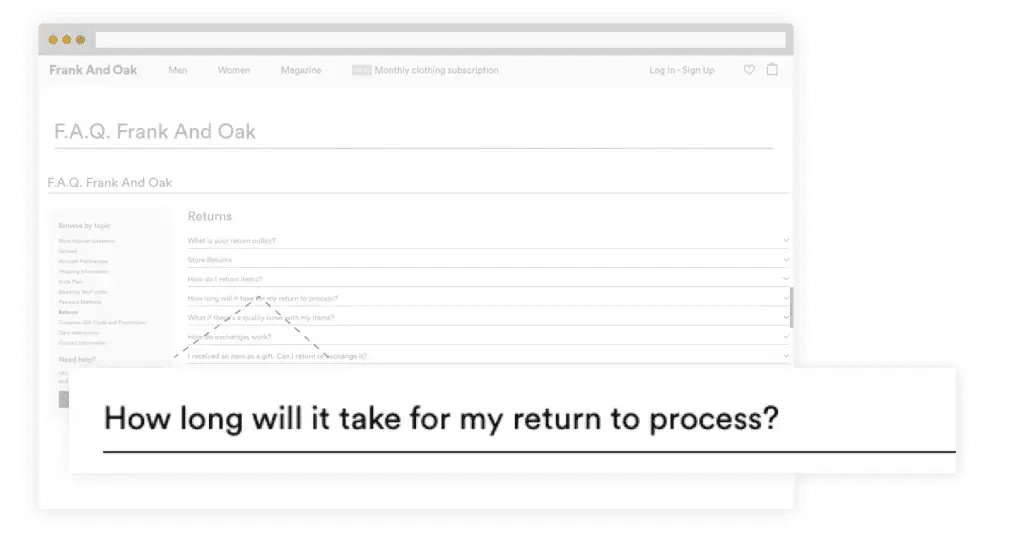
9. Share customer testimonials.
Studies have found 88% of people trust online reviews from other shoppers as much as they trust recommendations from personal contacts.
If satisfied customers explain how easy your return process was and how polite your customer service agents are, other shoppers will be more inclined to give it a try — and less likely to request a chargeback.
For example, Nectar lists several reviews from clients who have returned their mattresses.
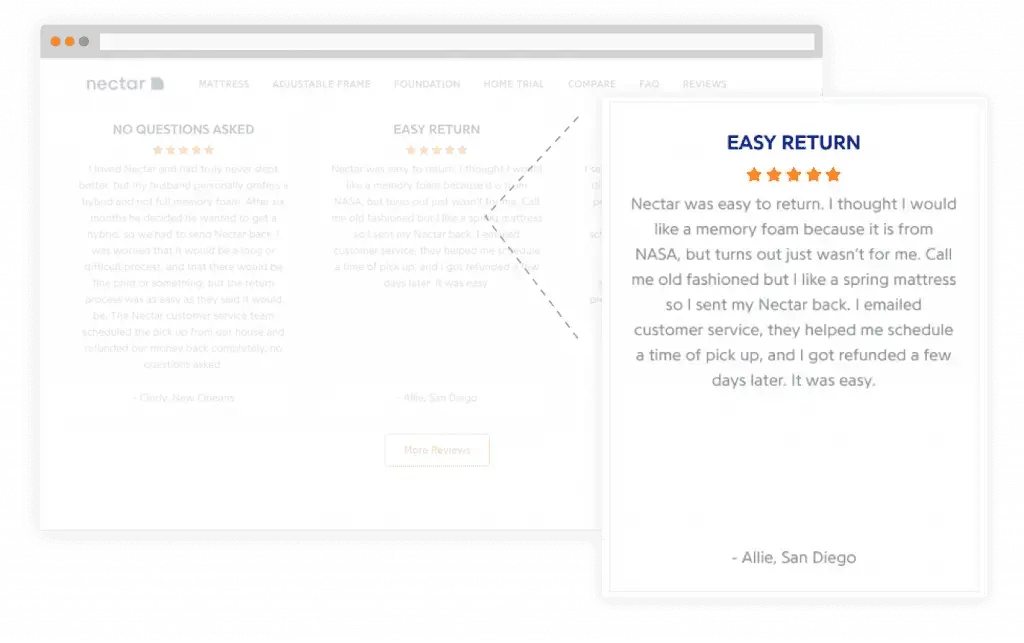
10. Honor old versions of your policy.
If you want to prevent as many chargebacks as possible, you’ll want to implement as many of these tips as possible. That will probably be a pretty significant overhaul.
Until all your shoppers have had a chance to familiarize themselves with your new policy, you’ll want to honor any requests that align with your old policy.
11. Monitor your outcomes.
Once you have your new policy in place, monitor your chargeback counts carefully. You might need to continue to tweak your policy until you find a perfect fit for you and your clients.
This will likely be an ongoing project. Customer expectations change over time. You’ll want to prevent chargebacks and reduce revenue loss, but with as little friction as possible.
12. Make it easy to find your policy.
You’ve worked hard to create the perfect return policy. Now, make sure people can find it!
You’ll want to include links to your return policy in the following places:
- Your homepage
- In all product or service descriptions
- On the checkout page near the Buy button
- The order confirmation email
Land’s End outlines their return policy as part of each product description.
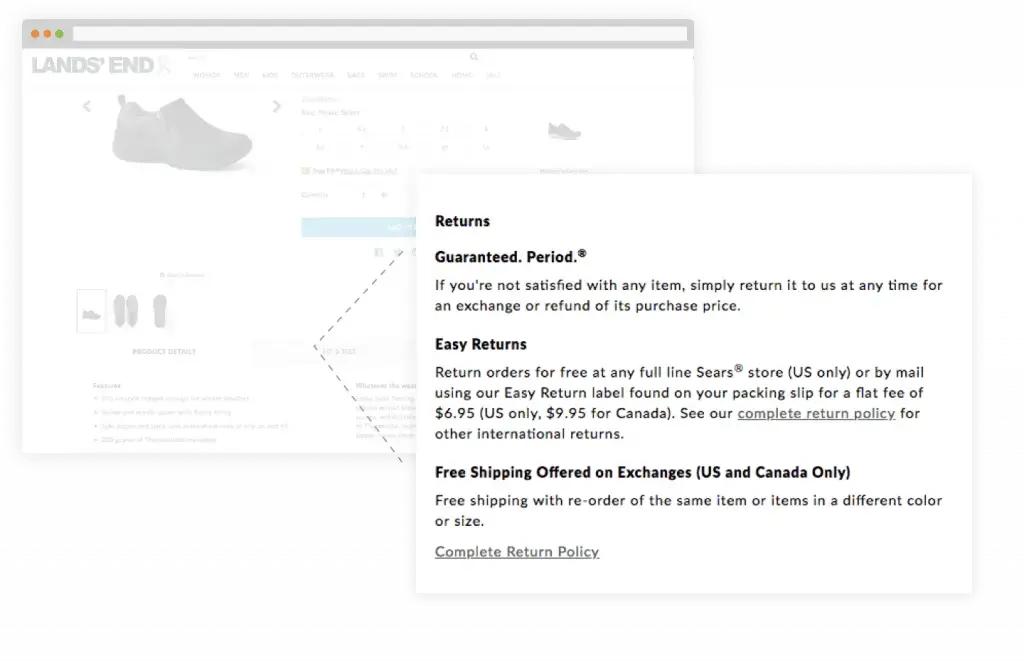
13. Educate your staff.
Share your policy with all team members involved in customer service and order fulfillment. Make sure everyone is familiar with expectations and will comply with your guidelines.
- All team members need to know which refund requests should and shouldn’t be fulfilled.
- If you receive an unqualified return, meaning it doesn’t comply with your policy, you’ll want to reach out to the customer right away. Try to find a mutually-satisfying way to resolve the issue. You can’t just ignore the return because it didn’t follow the rules.
- Refunds need to be issued promptly.
- Team members should notify the customer when the refund has been issued and mention when a credit can be expected.
Do You Want to Prevent More Chargebacks?
Updating your return policy can help prevent chargebacks, but it is just one of many strategies involved in comprehensive protection. There are several different tools and tactics you’ll want to implement at various stages of the customer journey.
If you’d like to learn more about what is involved in a multi-layer prevention strategy, contact Kount today. Our risk management experts aim to remove the complexity of payment disputes and would be happy to offer even greater insight to help you prevent chargebacks.